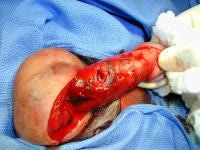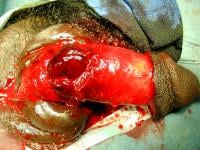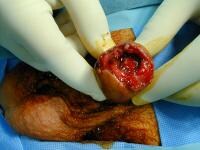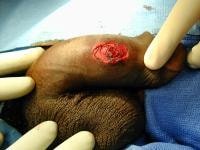Blog Archive
fblike
balacinema
Balaguris89
widgeonline dan amungonline kirteng
networkedblogs
iklan adsensecamp
Fraktur dan Trauma Penis- Mungkinkah terjadi?
Trauma Luka dan fraktur pada penis (Penile fracture and trauma) dapat di sebabkan oleh beberapa faktor. Fraktur Fraktur penile, amputasi penile, penetrasi injuri, dan injuri jaringan lunak penile adalah termasuk dalam kategori kegawatdaruratan urologi dan biasanya dilakukan intervensi pembedahan.
Tujuan penataksanaan pada trauma ini adalah universal: preservasi dari pada panjang penis, fungsi ereksi, dan pemeliharaan kemampuan kencing dengan berdiri.
Author: Richard A Santucci, MD, FACS, Chief of Urology, Detroit Receiving Hospital; Specialist-in-Chief of Urology, Detroit Medical Center; Chief of Urologic Trauma Surgery, Sinai Grace Hospital; Director, The Center for Urologic Reconstruction; Clinical Professor of Urology, Michigan State College of Medicine
Coauthor(s): Joshua A Broghammer, MD, Resident Physician, Department of Urology, Wayne State University
Contributor Information and Disclosures
Fraktur penis
Penile fracture is the traumatic rupture of the corpus cavernosum. Traumatic rupture of the penis is relatively uncommon and is considered a urologic emergency.
Sudden blunt trauma or abrupt lateral bending of the penis in an erect state can break the markedly thinned and stiff tunica albuginea, resulting in a fractured penis. One or both corpora may be involved, and concomitant injury to the penile urethra may occur. Urethral trauma is more common when both corpora cavernosa are injured.
Penile rupture can usually be diagnosed based solely on history and physical examination findings; however, in equivocal cases, diagnostic cavernosography or MRI should be performed. Concomitant urethral injury must be considered; therefore, preoperative retrograde urethrographic studies should generally be performed.
Small penile fracture involving the right corpus cavernosum.
More severe penile fracture.
Penile amputation
Penile amputation involves the complete or partial severing of the penis. A complete transection comprises severing of both corpora cavernosa and the urethra. Amputation of the penis may be accidental but is often self-inflicted, especially during psychotic episodes in individuals who are mentally ill.
Partial penile amputation.
Penetrating injury
Penetrating injury is the result of ballistic weapons, shrapnel, or stab injuries to the penis. Penetrating injuries are most commonly seen in wartime conflicts and are less common in civilian medicine. Penetrating injuries can involve one or both corpora, the urethra, or penile soft tissue alone.
Gunshot wound to the penis.
Penile soft tissue injury
Penile soft tissue injury can result through multiple mechanisms, including infection, burns, human or animal bites, and degloving injuries that involve machinery. The corpora, by definition, are not involved.
History of the Procedure
Penile fracture
Historically, conservative management was considered the treatment of choice for penile fractures. Conservative therapy consisted of cold compresses, pressure dressings, penile splinting, anti-inflammatory medications, fibrinolytics, and suprapubic urinary diversion with delayed repair of urethral injuries.
This concept has fallen into disfavor because of the high complication rates (29-53%) of nonoperative therapy. Complications of conservative management included missed urethral injury, penile abscess, nodule formation at the site of rupture, permanent penile curvature, painful erection, painful coitus, erectile dysfunction, corporourethral fistula, arteriovenous fistula, and fibrotic plaque formation.2
The primary goals of surgical repair are to expedite the relief of painful symptoms, to prevent erectile dysfunction, to allow normal voiding, and to minimize potential complications due to delay in diagnosis.
Currently, the vast majority of authors favor immediate surgical repair, citing fewer complications, increased patient satisfaction, shorter hospital stays, and better outcomes.
Penile amputation
Ehrich et al3 reported the first macroscopic reimplantation of a penile amputation, in which arterial anastomosis is not performed. Functional and cosmetic results were satisfactory, but penile skin necrosis was common. Tamai et al later modified the technique to include microsurgical reanastomosis of the penile blood vessels and nerves, thereby reducing the risk of penile skin necrosis. Reanastomosis requires the amputated penile remnant. In the case of distal penile loss, phallus reconstruction can be performed using a forearm free flap.
Frequency
Penile fracture
The frequency of penile fracture is likely underreported in the published literature. Trauma during sexual relations is responsible for approximately one third of all cases; the female-dominant position is most commonly reported. The mechanism of action may lead to embarrassment, causing patients to avoid seeking treatment and contributing to late presentation. As of 2001, 1331 cases were reported in the literature. The incidence of concomitant urethral injury in reported cases is 10-58%.
Penile amputation
Penile amputation is rare, with most cases being reported sporadically. Cases are typically associated with self-mutilation related to acute psychotic episodes or gender dysphoria. Felonious assaults account for the remainder of cases.
Penetrating injury
Gunshot wounds account for 35% of all genital injuries. In 25% of cases, the penis alone is involved. In another 25% of cases, both the penis and scrotum are involved.
The frequency of stab wounds to the penis is relatively rare, accounting for only 4% of penetrating penile injuries.
Penile soft tissue injury
Soft tissue skin loss of the penis is a rare phenomenon. Fournier gangrene accounts for approximately 75% of cases that involve genital skin loss. This infectious process is beyond the scope of this article and can be found in Fournier Gangrene. The remainder of soft tissue loss cases are typically due to avulsion injuries, human or animal bites, and burns.
Etiology
Penile fracture
In the Western Hemisphere, penile fracture usually occurs during sexual intercourse when the penis slips out of the vagina and strikes the perineum or the pubic symphysis. Other potential causes include industrial accidents, masturbation, gunshot wounds, or any other mechanical trauma that causes forcible breaking of an erect penis.
In Middle Eastern countries, the injury is usually due to penile manipulation to achieve detumescence. Additional rare etiologies include turning over in bed, a direct blow, forced bending, or hastily removing or applying clothing when the penis is erect.
Penile amputation
Penile amputation frequently occurs as a result of mental illness; in fact, most cases of penile amputation in the Western world are due to mental illness. The rate of mental illness–related penile amputation is as high as 87%. Most of these patients (51%) have acutely decompensated schizophrenia. The literature reports a high rate of associated gender identity in nonpsychotic occurrences; most of these amputations result from an attempt at gender conversion. Cases of assault are also reported. A rash of these attacks occurred in Thailand during the 1970s, when a large number of enraged wives amputated the penises of their adulterous husbands.
Penetrating injury
Most penetrating penile injuries occur during wartime. As solid-organ abdominal injuries and subsequent death rates have been reduced with the use of body armor in modern warfare, the frequency of penetrating genital injuries has increased. This is because of two factors. The first is that body armor does not traditionally cover the genitals. The second is that genital injuries were likely underreported in previous wars because unprotected individuals tended to die of massive abdominal injuries. Extraction of injured soldiers from the combat theater and improvements in the treatment of trauma patients have also increased survival rates, leading to increased reporting of injuries to the penis.
Penile soft tissue injury
Avulsion injuries to the penis are typically due to entrapment of the penile skin within the clothing. This clothing is caught on moving machinery, such as motorcycles or farm implements, which rends the soft tissue from the stronger underlayer of the tunica albuginea.
Pathophysiology
The penis is composed of 3 bodies of erectile tissue: the corpus cavernosum (left and right) and the corpus spongiosum. Both corpora cavernosa are contained by the tunica albuginea. All three corpora are surrounded individually by Buck fascia.
All three corporal cylinders are capable of considerable enlargement with sanguineous engorgement during normal erection. The corpora cavernosa are composed of sinusoids that fill with arterial blood during erection.
The internal pudendal arteries provide the blood supply to the penis and the urethra. Each artery divides into the dorsal penile artery, the cavernosal artery, and the bulbourethral artery. The cavernosal artery supplies the corpus cavernosum.
Penile fracture
In the flaccid state, injury to the penis is rare because of the mobility and flexibility of the organ. During an erection, the arterial inflow to the penis causes the erectile bodies to enlarge longitudinally and transversely. This causes the flaccid penis to become fully erect and less mobile.
As the penis changes from a flaccid state to an erect state, the tunica albuginea thins from 2 mm to 0.25-0.5 mm, stiffens, and loses elasticity. The expansion and stiffness of the tunica albuginea impede venous return and are responsible for maintaining tumescence during male erection.
Sudden direct trauma to the penis or an abnormal bending of the penis in an erect state can cause a 0.5-4 cm transverse tear of the tunica albuginea, with injury to the underlying corpus cavernosum. Oblique or irregular tears are less common, but reported. The injury typically results in injury to one corpus cavernosa, but both can be involved. This may result in penile laceration and urethral injury.
Penile amputation
Penile amputation is not a physiological process.
Penetrating injury
The penis is somewhat resistant to penetrating injury owing to its location and relative mobility. The penis is shielded by the surrounding bony pelvis posteriorly and upper thighs laterally, thereby preventing injury.
Penile soft tissue injury
The penis is particularly susceptible to avulsion injuries. The overlying skin of the penis is loose and elastic. The penile skin must be highly mobile to accommodate both the rigid and flaccid state of the penis. This loose base predisposes the skin to be ripped easily from the penis.
Presentation
Penile fracture
The clinical presentation of a penile fracture is often fairly straightforward. Diagnosis is made based on history and physical examination findings. Most affected patients report penile injury coincident with sexual intercourse. Patients usually report that the female partner was on top, straddling the penis. During sexual relations, the penis slipped out, hitting the perineum or the pubis of the female partner. Patients sometimes report that they were having sexual relations on a desk (with the patient on top) and the penis slipped out, hitting the edge of the desk.
Patients describe a popping, cracking, or snapping sound with immediate detumescence. They may report minimal to severe sharp pain, depending on the severity of injury.
Upon physical examination, evidence of penile injury is self-evident. In a typical penile fracture, the normal external penile appearance is completely obliterated because of significant penile deformity, swelling, and ecchymosis (the so-called "eggplant" deformity).
Eggplant deformity.
Upon inspection, significant soft tissue swelling of the penile skin, penile ecchymosis, and hematoma formation are apparent. The penis is abnormally curved, often in an S shape. The penis is often deviated away from the site of the tear secondary to mass effect of the hematoma. If the urethra has also been damaged, blood is present at the meatus.
If the Buck fascia is intact, penile ecchymosis is confined to the penile shaft. If the Buck fascia has been violated, the swelling and ecchymosis are contained within the Colles fascia. In this instance, a "butterfly-pattern" ecchymosis may be observed over the perineum, scrotum, and lower abdominal wall.
The fractured penis is often quite tender to the touch. Because of the severity of pain, a comprehensive penile examination may not be possible. However, a "rolling sign" may be appreciated when a judicious examination is performed on a cooperative patient. A rolling sign is the palpation of the localized blood clot over the site of rupture. The clot may be felt as a discreet firm mass over which the penile skin may be rolled.
Patients with a rupture of the deep dorsal vein of the penis can present with findings similar to those of a penile fracture. Associated swelling and ecchymosis of the penis ("eggplant" sign) is present. Injury commonly occurs during sexual intercourse. However, the patient does not typically hear a crack or popping sound. In addition, detumescence does not immediately occur. However, because of similar physical examination findings, a deep dorsal vein rupture should be surgical explored, as it is often difficult to differentiate from penile fracture.
Patients with concomitant urethral trauma report hematuria upon postinjury voiding. Approximately 30% of men with penile fractures demonstrate blood at the meatus. Some patients may also report dysuria or experience acute urinary retention. Retention may be secondary to urethral injury or periurethral hematoma that is causing a bladder outlet obstruction. Urinary extravasation may be a late complication of unrecognized urethral injury. Successful voiding does not exclude urethral injury; therefore, retrograde urethrography is required whenever urethral injury is suspected. Signs and symptoms of urethral injury are described below.
Penile amputation
Diagnosis of the amputated penis is obvious on physical examination. A thorough history must be taken to determine the patient's mental state and if self-mutilation is responsible for the amputation. Many patients present to the hospital for evaluation because of the alarming, although seldom life-threatening, volume of blood loss.
Determination of the psychiatric state helps with operative planning. The literature suggests that, in cases of self-amputation, resolution of the acute psychotic episode and treatment of the underlying mental illness typically results in a desire for penile preservation. The only exception may involve men who have repeatedly attempted amputation. The risks of future self-mutilation must be weighed against the effects of no penile replacement.
Examination of the penis and remnant (if available) is important to determine the possible reconstructive options. The condition of the graft bed is closely inspected. Destruction of the amputated segment precludes reimplantation, and the patient should be prepared for future phallic reconstruction. Patients with adequate penile stumps may avoid reimplantation altogether, although this is typically a less desirable outcome. The cancer literature suggests that a penile length of 2-3 cm is necessary for directing the urinary stream while standing to void. The length required for sexual intercourse is likely longer but depends on body habitus and partner preference.
Extensive physical examination should not delay operative intervention, as a better examination is likely to be obtained in the operating room with the patient under anesthesia.
Penetrating injury
Diagnosis of a penetrating penile injury is obvious based on both history and physical examination findings. Care must be paid to the patient's other associated injuries, which can be life-threatening and should take precedence over genital injuries. Significant associated injuries are present in 50-80% of cases. The patient must be medically stabilized prior to surgical repair of the injured penis.
Blood in the meatus can indicate urethral injury and should be suspected in any penetrating trauma to the penis. The authors routinely perform retrograde urethrography to evaluate for urethral injury.
Penetrating injuries to the corpora cavernosa often have a hematoma that overlies the defect and have a "rolling sign" similar to that of penile fracture.
Penile soft tissue injury
Examination of the penis reveals soft tissue loss. Those who have undergone laceration secondary to a human bite usually present in a delayed fashion because of embarrassment of the injury. This places them at increased risk for infection, which may be seen in the form of abscess, cellulitis, or tissue necrosis.
Urethral Injury
Signs and symptoms of urethral injury should be considered in all forms of penile trauma. The mechanism of penile injury and physical examination findings must be considered. The diagnostic test of choice is retrograde urethrography. The key indications of urethral injury are as follows:
- Blood at the meatus
- Gross hematuria
- Microscopic hematuria (>5 RBCs per high-power field)
- Dysuria
- Urinary retention
Indications
Penile fracture
Indications for immediate surgical intervention include the presence of obvious clinical signs and symptoms of penile fracture. Diagnostic imaging studies are not normally required in this setting. Surgery is also warranted if diagnostic cavernosography or MRI findings are equivocal but clinical findings are consistent with penile fracture.5
Penile amputation
Penile amputation is a surgical emergency. Imaging studies are not necessary. The patient should be taken to the operating room for penile replantation or revision of the penile stump, with or without plans for future phallic reconstruction.
Penetrating injury
The signs of penetrating penile injury should be an indication for surgical exploration. The only contraindication to surgery is medial instability due to other associated injuries. In rare instances, penile trauma can be treated nonoperatively. In one series, 10 of 26 patients were managed without surgery. These patients had two factors that contributed to nonoperative treatment. One group (3 patients) had minimal injuries with a single shotgun pellet lodged in the penis. The other group had only superficial or isolated foreskin injuries.
Penile soft tissue injury
Surgical repair of soft tissue loss to the penis should be undertaken quickly. Prolonged exposure of the denuded penis increases the risk of secondary infection.
Relevant Anatomy
The penis is divided into 3 parts. The root lies under the pubic bone and provides stability when the penis is erect. The body comprises the major portion of the penis and is composed of 2 cavernosal bodies and a corpus spongiosum. The urethra traverses the corpus spongiosum to exit through the meatus. The 2 cavernosal bodies (ie, corpus cavernosa, erectile bodies) produce erections when filled with blood. The glans is the distal expansion of the corpus spongiosum. The loose skin of the prepuce normally covers the glans of an uncircumcised penis.
The penis is innervated by the left and right dorsal nerves, which are the main sensory nerve supply. These nerves are typically located at the 10- and 2-o'clock positions, but, in reality, their locations significantly vary. Care must be taken with surgical exploration of any penile injury to avoid iatrogenic injury to the dorsal nerves. The penis is also innervated by branches of the pudendal nerve.
The penis is a highly vascular organ and is supplied by the internal pudendal artery. The internal pudendal artery rises from the internal iliac artery (ie, hypogastric artery), which then branches into the deep artery of the penis, the bulbar artery, and the urethral artery. The deep artery of the penis becomes the cavernosal arteries, which supply the entire corpus cavernosum. The urethral artery supplies the glans penis and corpus spongiosum. The bulbar artery supplies the bulbar urethra and the bulbospongiosus muscle.
Contraindications
Contraindications to surgical therapy include intolerance to general anesthesia and a history of penile trauma but completely normal physical examination findings. In patients with polytrauma, life-threatening injuries must be prioritized; delayed penile repair can be considered when the patient becomes medically stable.6 Patients with penile trauma require fluid resuscitation prior to operative intervention.
Artikel Lainnya
Label
Ageing
(1)
Alergi
(4)
Asma bronkial
(2)
Bedah
(6)
Bedah Digestif
(2)
Cardiology
(1)
COPD
(1)
Dermato Venerology
(9)
Diabetes Melitus
(4)
Emergency
(3)
Farmakologi
(1)
Fisiologi
(1)
GCS
(1)
Generals
(33)
GIT Tract
(8)
Herbal
(1)
Imunologi
(2)
Infertilitas
(1)
Infos
(2)
Interna
(31)
Jurnal Kedokteran
(34)
Kelainan Genetik
(1)
Masalah Pria
(1)
Masalah Wanita
(1)
Mentalic
(1)
Mineral
(1)
Neurology
(6)
Neurology - Penyakit Saraf
(6)
Nutrisi dan Gizi
(2)
Obstetri dan Ginekologi
(3)
Pediatri
(5)
Pengobatan dan Obat-obatan Alternatif
(1)
Penis
(2)
Penyakit Jantung dan Pembuluh Darah
(1)
Penyakit Kulit dan Kelamin
(1)
Penyakit Menular
(6)
Praktis
(8)
Pulmonologi
(7)
Radiologi
(1)
Request
(1)
research
(1)
Rumah Sakit
(1)
Sinusitis
(1)
Suplemen makanan
(2)
TBC - Tuberculosis Paru
(4)
Terapi
(1)
THT
(3)
Trauma Kepala
(1)
Tropical Disease
(1)
Urologi
(1)
Vagina
(1)
Vitamin
(1)











